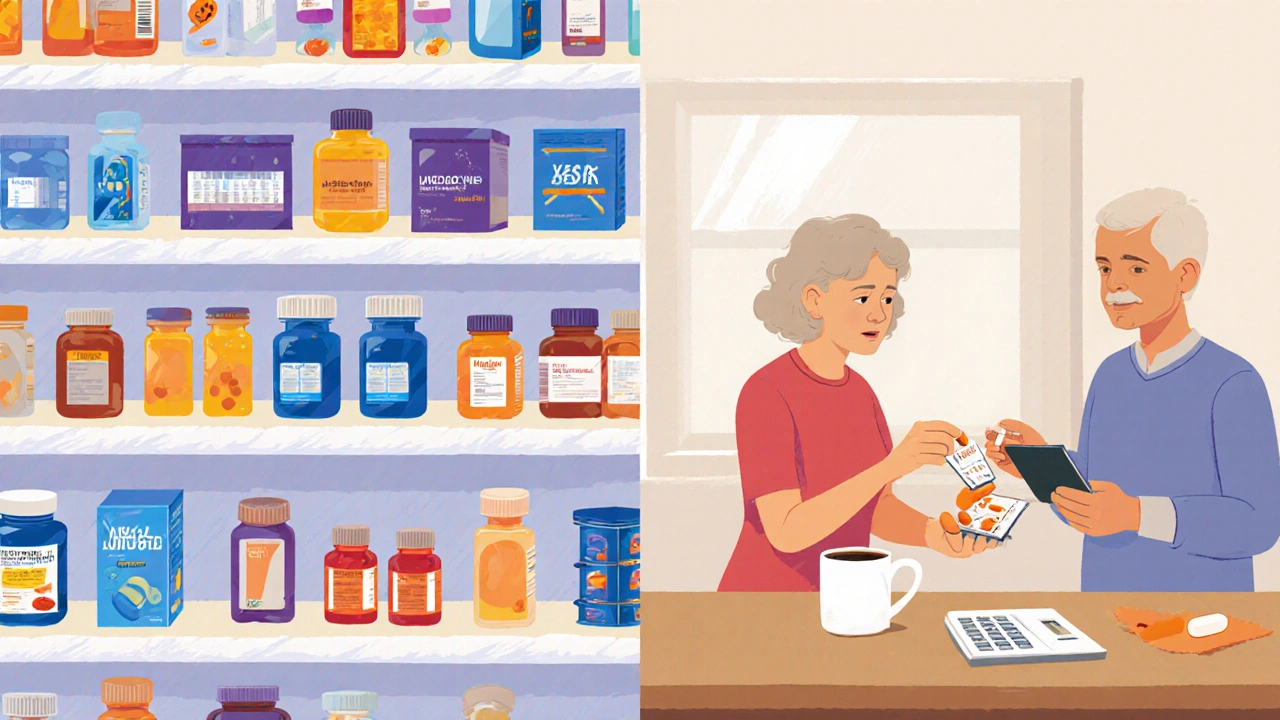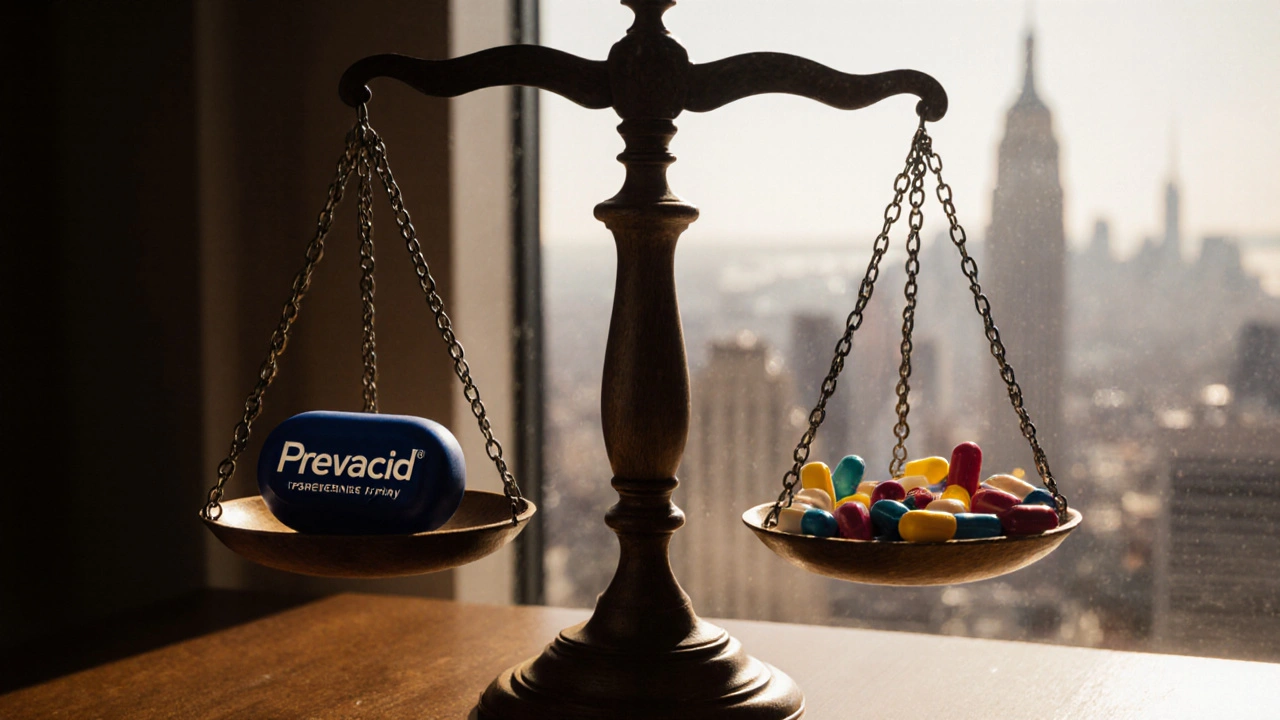Prevacid vs Other Acid Reducers Comparison Tool
Select Your Condition & Preferences
Recommended Option:
When it comes to battling heartburn, ulcer pain, or gastro‑esophageal reflux disease (GERD), Prevacid is a name that pops up a lot. Prevacid is the brand name for lansoprazole, a proton‑pump inhibitor (PPI) that blocks the stomach’s acid‑making engine. It’s been on the market since the early 2000s and is prescribed millions of times a year in the UK and beyond. But is it the best fit for you, or do other acid‑reducing meds deserve a closer look? This guide breaks down the science, the side‑effect profile, and the real‑world quirks that set Prevacid apart from its rivals.
Key Takeaways
- Prevacid (lansoprazole) is a PPI that offers fast, long‑lasting acid suppression.
- Other PPIs-omeprazole, esomeprazole, pantoprazole, rabeprazole-share the same mechanism but differ in potency, dosing flexibility, and cost.
- H2‑blockers such as ranitidine and famotidine work on a different step of acid production and are quicker but shorter‑acting.
- Choosing the right drug depends on your condition severity, lifestyle, drug interactions, and how you respond to treatment.
- Long‑term PPI use carries risks (bone density loss, vitamin B12 deficiency, infections); monitoring and periodic breaks can mitigate these.
What Is Prevacid (Lansoprazole)?
Prevacid belongs to the PPI family, which means it irreversibly shuts down the H⁺/K⁺‑ATPase enzyme-the “pump” that secretes acid in the gastric parietal cells. By targeting the final step of the acid‑production cascade, it reduces both basal and stimulated acid output, giving relief that can last up to 24hours after a single dose.
Typical dosing is 15mg or 30mg once daily, taken before a meal. For severe erosive esophagitis, doctors may prescribe 30mg twice daily for a short period. Unlike antacids that neutralize acid already present, PPIs like Prevacid prevent new acid from forming, which is why they’re the go‑to choice for chronic conditions.
How Prevacid Stacks Up Against Other PPIs
All PPIs share the same target, but they differ in pharmacokinetics, onset speed, and drug‑interaction profile. Below is a quick snapshot of the most common alternatives.
| Attribute | Prevacid (Lansoprazole) | Omeprazole | Esomeprazole | Pantoprazole | Rabeprazole |
|---|---|---|---|---|---|
| Typical Dose | 15‑30mg once daily | 20‑40mg once daily | 20‑40mg once daily | 20‑40mg once daily | 20mg once daily |
| Time to Peak Effect | 1‑2h | 1‑2h | 1‑2h | 2‑3h | ~1h |
| Half‑Life (plasma) | 1.3h | 0.8h | 1.0‑1.5h | 1.0h | 0.9h |
| Metabolism Pathway | CYP2C19, CYP3A4 | CYP2C19, CYP3A4 | CYP2C19 (major), CYP3A4 | CYP2C19, CYP3A4 | CYP2C19, CYP3A4 |
| Cost (UK NHS) | £1.70 per tablet | £0.90 per tablet | £1.80 per tablet | £1.20 per tablet | £1.00 per tablet |
| Notable Advantages | Strong acid control, good for erosive disease | Widely available, cheap | Highest bioavailability, works well in CYP2C19 poor metabolizers | Less drug‑drug interaction potential | Fast onset, less affected by food timing |
| Common Drawbacks | Can be pricier than omeprazole | Variable response in fast metabolizers | Higher price, similar side‑effects | Slower onset for severe night‑time reflux | May cause mild headache more often |
In practice, the choice often boils down to how you react. Some patients on omeprazole notice a “rebound” acid increase when they stop, while others on esomeprazole enjoy smoother symptom control. Prevacid tends to sit in the middle-strong enough for most ulcer repairs, yet not as costly as esomeprazole.

H2‑Blockers vs. PPIs: When Speed Beats Duration
While PPIs shut the main pump, H2‑blockers like Ranitidine and Famotidine target histamine receptors on parietal cells. They’re quicker-often relieving symptoms within 30minutes-but their effect wanes after 6‑12hours.
If you need occasional relief after a heavy dinner, an H2‑blocker can be more convenient. However, for chronic GERD, the acid‑burst they allow at night can damage the esophagus over time. The rule of thumb: use H2‑blockers for “as‑needed” relief, PPIs for maintenance therapy.
Safety, Side‑Effects, and Long‑Term Risks
All PPIs, including Prevacid, share a safety profile that’s generally well‑tolerated. The most common complaints are headache, nausea, and mild diarrhea-usually harmless and often fade after a few weeks.
More serious concerns emerge with prolonged use (over six months). Studies from the British Medical Journal (2023) link chronic PPI use to a modest increase in osteoporosis‑related fractures, especially in post‑menopausal women. Vitamin B12 absorption can also drop because acid aids its release from food.
Infection risk is another factor. Lower stomach acidity can let bacteria like Clostridioides difficile thrive, raising the odds of severe diarrhea. A 2022 cohort study in the Lancet found a 1.5‑fold rise in C.diff infection among long‑term PPI users compared to non‑users.
To balance benefits and risks, physicians often recommend “step‑down” strategies: start with a PPI to heal the lining, then taper to the lowest effective dose or switch to an H2‑blocker for maintenance.
Practical Tips for Getting the Most Out of Your Acid Reducer
- Take it before a meal. PPIs need an acid‑stimulating meal to activate the pump‑inhibiting effect.
- Don’t crush or chew the tablet-this can destroy the enteric coating that protects the drug from stomach acid.
- Watch for drug interactions. PPIs can increase levels of anticoagulants (warfarin), clopidogrel, and certain HIV meds by inhibiting CYP2C19.
- Consider timing. If night‑time reflux is a problem, a bedtime dose of an H2‑blocker can supplement a daytime PPI.
- Schedule a check‑up after three months of continuous use. Your doctor may order a bone‑density scan or a B12 level.
How to Choose the Right Acid‑Reducing Medication for You
Here’s a quick decision tree you can run through with your clinician:
- Are symptoms occasional (<2times/week) or chronic?
If occasional, start with an H2‑blocker; if chronic, move to a PPI. - Do you have risk factors for osteoporosis or low B12?
If yes, prefer a cheaper, short‑acting PPI like omeprazole and schedule regular monitoring. - Are you on medications that use CYP2C19?
If yes, consider esomeprazole (less affected by enzyme variation) or pantoprazole (lowest interaction profile). - Cost matters?
Omeprazole is typically the most affordable; Prevacid sits mid‑range. - Do you need rapid relief?
Combine a nighttime dose of famotidine with a morning PPI.
Remember, no single drug fits everyone. The best plan balances symptom control, safety, and your personal circumstances.

Frequently Asked Questions
Can I switch from Prevacid to another PPI without a doctor’s approval?
You can change PPIs, but it’s wise to consult a physician first. Some people experience different side‑effects or varying efficacy, and a doctor can help you pick the one that matches your metabolism and other meds.
How long should I stay on Prevacid for an ulcer?
Typical ulcer healing takes 4‑8weeks on a full dose (30mg daily). Your doctor will schedule a follow‑up endoscopy to confirm healing before tapering.
Is Prevacid safe during pregnancy?
Category B (UK) - animal studies show no risk, but human data are limited. Many obstetricians prescribe it when benefits outweigh potential unknowns, especially for severe GERD.
What’s the difference between Prevacid and over‑the‑counter (OTC) lansoprazole?
OTC versions usually come in 15mg tablets for short‑term use (up to 14days). Prescription Prevacid can be higher strength and part of a longer treatment plan under medical supervision.
Can I take Prevacid with an antacid like Gaviscon?
Yes, but space them out. Take Prevacid first, wait about 30minutes, then have the antacid. Mixing them together can neutralize the PPI’s effect.
Bottom line: Prevacid is a solid, well‑studied PPI that works for most people with moderate to severe acid‑related conditions. Yet alternatives-whether other PPIs or H2‑blockers-offer nuances that can better suit specific health profiles, budgets, or lifestyle needs. Talk with your pharmacist or doctor, run through the decision points above, and you’ll land on a regimen that keeps the burning down and the side‑effects low.


chris mattox
September 29, 2025 AT 02:26Hey folks, navigating the acid‑reducer maze can feel like wandering through a foggy market.
Let’s untangle the threads together, because you deserve clarity.
Prevacid, known as lansoprazole, steps onto the stage as a sturdy PPI, shutting the gastric pump with gusto.
Its onset clock ticks around one to two hours, granting a day‑long shield for most sufferers.
Compared to its cousin omeprazole, Prevacid often rides a slightly higher price tide in the UK, yet its potency can justify the extra pennies for erosive esophagitis.
If budget whispers “tighten the belt,” plain‑old omeprazole still delivers respectable relief at half the cost.
For those chasing the zenith of bioavailability, esomeprazole dazzles, especially if you’re a CYP2C19 poor metabolizer.
Meanwhile, pantoprazole courts patients wary of drug‑drug interactions, thanks to a modest CYP profile.
H2‑blockers, like famotidine, sprint in faster but fizzle out after half a day, making them perfect for occasional fire‑breathers after a rich feast.
Remember, PPIs need food to ignite their activation; pop that tablet before breakfast for maximal effect.
Swallow them whole-crushing kills the enteric coat and throws the medicine to the acid gauntlet.
Long‑term use, beyond six months, can coax bone density whispers, B12 dips, and a sneaky rise in C. diff infections, so keep your doctor in the loop.
A smart strategy is “step‑down”: start strong, then taper to the lowest effective dose or switch to an H2‑blocker for maintenance.
If night‑time reflux spikes, a bedtime famotidine can patch the gaps while your PPI does the heavy lifting during the day.
Periodic labs-check B12, iron, magnesium-can catch silent shortfalls before they become trouble.
Bottom line: match the medication to your symptom rhythm, budget, and health backdrop, and you’ll tame the acid dragon without collateral damage.
Jackson Whicker
September 30, 2025 AT 06:12Ah, the grand theater of gastric suppression unfolds before us, and yet many stumble over the curtain of choice.
Prevacid, you say? It is merely one actor in a repertory of proton‑pump inhibitors, each vying for the spotlight of acid quelling.
Omeprazole, the workhorse, has earned its ubiquity by virtue of cost, while esomeprazole, the aristocrat, flaunts superior bioavailability at a princely price.
Pantoprazole attempts to be the diplomat, courting patients wary of CYP‑mediated interactions.
Yet let us not be hoodwinked by marketing gloss; the pharmacokinetic nuances are but statistical whispers to the layman.
The true measure lies in patient response-some will sing praises for lansoprazole’s robust ulcer healing, others will lament its modest wallet‑impact.
Moreover, the myth that PPIs are benign for eternity must be cast aside; the literature, albeit sometimes subdued, hints at bone‑density erosion and microbial dysbiosis.
In the grand scheme, one must wield these agents with a surgeon’s precision, not a farmer’s indiscriminate sowing.
Therefore, before you pledge fealty to any single compound, interrogate the clinical evidence, your own physiology, and the fiscal reality.
Only then shall you orchestrate a symphony of symptom relief rather than a cacophony of side effects.
Audrin De Waal
October 1, 2025 AT 14:00Listen up, mates-when it comes to taming that burning beast in the gut, the UK’s own Prevacid doesn’t just sit on the shelf, it stands tall like the Queen’s Guard.
It smashes acid faster than a London bus trundles through rush hour, and the Brits have trusted it for decades.
Compared to those cheap imports like omeprazole, which feel like a budget airline, Lansol shines with proper punch.
And don’t get me started on the fancy‑priced esomeprazole-just a posh name for what the rest of us can get with a fraction of the cost.
If you’re serious about beating reflux, grab the home‑grown option and leave the knock‑offs to the tourists.
Remember, a strong acid reducer is a British tradition, not some foreign fad.
Keep your stomach as disciplined as a Buckingham guard, and the burn will bow.
parag mandle
October 2, 2025 AT 19:10Hey there, I see you’ve painted a vivid picture of the PPI arena, and I’d like to add a practical brushstroke.
While the pharmacologic distinctions are intriguing, clinicians often start patients on the cheapest effective PPI-usually omeprazole-then switch if healing stalls.
If a patient metabolizes CYP2C19 rapidly, lansoprazole or esomeprazole may indeed outperform omeprazole, which is why a simple genotyping test can guide therapy.
Also, adherence improves when dosing is simple: a once‑daily tablet taken before breakfast works for most.
For night‑time symptoms, pairing a bedtime H2‑blocker with a daytime PPI can close the residual acid gap.
Lastly, always reassess after 8‑12 weeks; many patients can taper to the lowest dose or even discontinue.
This step‑down approach balances efficacy with the long‑term safety concerns you highlighted.
Shivali Dixit Saxena
October 3, 2025 AT 16:00Take your meds before meals!!!
Sayam Masood
October 4, 2025 AT 14:13Indeed, timing is the keystone of PPI success-administering the capsule 30‑60 minutes prior to the first bite triggers the proton pump in its active state, ensuring maximal inhibition.
Skipping this window can render the drug half‑effective, akin to trying to fill a bucket with a hole at the bottom.
For patients with erratic meal patterns, a bedtime dose of an H2‑blocker can mop up nocturnal acid spikes that the daytime PPI might miss.
Always confirm the patient’s schedule before prescribing, as adherence often crumbles under complexity.
In practice, a simple reminder on the phone or a pill organizer can bridge the gap between theory and reality.
Thus, the “when” is as pivotal as the “what” in acid‑suppression therapy.
Jason Montgomery
October 5, 2025 AT 23:33Hey team, just wanted to give a quick shout‑out to anyone feeling stuck on the whole “which acid reducer is right?” jam.
Think of it like picking the right shoe for a hike-you need comfort, durability, and the right fit for the terrain.
If you’re dealing with occasional heartburn after a spicy curry, a famotidine pop‑up might be the light‑weight sneaker you need.
But if you’ve got chronic GERD that’s been a marathon, a daily PPI like Prevacid or omeprazole is your sturdy hiking boot.
Keep an eye on the price tag too; the cheaper options work fine for many, and you can always step up if symptoms linger.
Don’t forget to chat with your doc about tapering after a few months-staying on a high dose forever isn’t always necessary.
Stay motivated, listen to your body, and you’ll find the sweet spot without burning out.
Wade Developer
October 7, 2025 AT 03:20In the contemporary discourse on gastro‑oesophageal therapeutics, the selection of a proton‑pump inhibitor warrants a judicious appraisal of both pharmacodynamic attributes and socioeconomic variables.
Lansoprazole, commercialized as Prevacid, exhibits a plasma half‑life of approximately 1.3 hours, yet its irreversible inhibition of the H⁺/K⁺‑ATPase confers a duration of action extending to 24 hours.
Comparative pharmacokinetic analyses reveal that omeprazole, while possessing a shorter half‑life, achieves comparable acid suppression when administered consistently.
Esomeprazole, the S‑enantiomer of omeprazole, demonstrates marginally enhanced bioavailability, a factor of relevance in patient cohorts characterized by extensive CYP2C19 metabolism.
Pantoprazole’s relatively reduced drug‑drug interaction profile can be advantageous for polypharmacy scenarios, particularly in the elderly.
Nevertheless, the clinical efficacy must be balanced against documented long‑term sequelae, including attenuated calcium absorption and susceptibility to Clostridioides difficile infection.
A prudent therapeutic algorithm thus commences with an evidence‑based, cost‑effective agent, followed by escalation predicated upon therapeutic response and tolerability.
Regular reevaluation at eight‑ to twelve‑week intervals facilitates dose optimization and mitigates undue exposure.
Accordingly, the clinician’s fiduciary duty encompasses both symptomatic amelioration and the mitigation of iatrogenic risk.
This dialectic underscores the imperative for personalized medicine within the realm of acid suppression therapy.
Sandra Perkins
October 7, 2025 AT 17:13Sure, just pop a magic pill and your stomach will be a zen garden-no side effects, right?
rama andika
October 8, 2025 AT 21:00Oh, absolutely, because the pharmaceutical giants are definitely not pulling strings to shove pricey esomeprazole on us while keeping the inexpensive omeprazole under the table. They’ve even embedded micro‑chips in the pills to track our heartburn frequencies-at least that’s the rumor swirling in the back‑alley forums. In reality, though, the data you laid out is solid, but remember that each “cost‑effective” label often masks a hidden markup funded by lobbying. So, while you’re balancing bioavailability against budget, ask yourself who profits when you switch brands. A little skepticism never hurts, especially when your pharmacist’s smile might be a cover for the next big drug‑price surge.